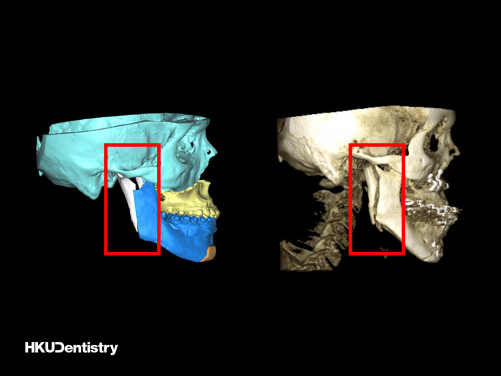Media
HKU Oral and Maxillofacial study shows internal fixation surgery linked with improvement in long jaw patients’ quality of life
23 May 2023

HKU Dentistry Oral and Maxillofacial Surgery research team: Dr Mike Leung (left) and Ms Natalie Wong compare the changes of patients’ quality of life (QoL) after receiving IVRO or SSRO as the treatment for mandibular prognathism.

Intraoral vertical ramus osteotomy (IVRO): (Left) The pre-operative virtual surgical planning (red frame); (Right) The post-operative CT scan (red frame).
With a normal bite, the upper jaw and teeth are sitting slightly in front of the lower jaw. However, when people are described as having a long face or a prominent jaw, they may have a condition called mandibular prognathism which refers to the overdevelopment of the lower jaw. The condition is a facial deformity and affects the chewing function, facial aesthetic, and self-esteem of the individual, as well as causing jaw joint pain.
Mandibular prognathism is a common facial deformity in Hong Kong and Southern China when compared to Western countries. The correction of mandibular prognathism requires orthognathic surgery, which involves creating a split in the jawbone(s) and fix in a planned position. Intraoral vertical ramus osteotomy (IVRO) and sagittal split ramus osteotomy (SSRO) are the two common surgical techniques of the lower jaw to setback the elongated lower jaw. IVRO is an older technique that requires intermaxillary fixation to achieve bone fixation, i.e. locking the upper and lower jaws with wire, for 6 weeks. During this period, the patient can only take fluid diets. SSRO, in contrast, allows internal fixation using titanium plates and screws, which enables immediate jaw function after the surgery. Both techniques are commonly used in Hong Kong and Eastern Asia in treating patients with mandibular prognathism.
Previous studies showed IVRO carried less risk of injury to nerve that supplies the lower lip sensation when compared to SSRO which may also require a second small operation to remove the titanium plates and screws if they are exposed or infected. However, the need of intermaxillary fixation is a concern but was not evaluated from the patients’ perspective.
A study led by Dr Mike YY Leung, Clinical Associate Professor in Oral and Maxillofacial Surgery, Faculty of Dentistry The University of Hong Kong, compared the changes of patients’ quality of life (QoL) after receiving IVRO or SSRO as the treatment for mandibular prognathism. A total of 98 patients were randomized to receive IVRO (49 patients) or SSRO (49 patients) as the mandibular setback procedure of their orthognathic surgery. The patients’ QoL were assessed by two self-administered questionnaires, namely 14-item Short-Form Oral Health Impact Profile (OHIP-14) to evaluate the oral-health related QoL, and 36-item Short-Form Health Survey (SF-36), to evaluate the physical and mental health-related quality of life. The longitudinal changes of the patients’ QoL were analyzed and compared up to two post-operative years.
The study found that after an early recovery period from the surgery, the oral health-related quality of life in patients both IVRO and SSRO groups were significantly better from post-operative 3 months onwards when compared to the pre-operative status and continued to improve steadily afterwards. Besides, it was found that patients who underwent the surgery at younger ages had a better oral health-related QoL during the postoperative period.
For the physical and mental health-related QoL, it was found that the burden of physical impact was bigger than the psychological impact in both groups in the early postoperative period. Social functioning, emotion, and mental health specifically affected patients in the IVRO group. These findings suggested that mental health was continuously affected during the intermaxillary fixation period. Eventually, physical and mental health–related QoL of patients in both groups were able to return to baseline level or even better at 2 years after the surgery. The study showed that IVRO and SSRO could both improve patients’ physical and mental health in the long term.
When comparing the two surgical procedures, it was found that the patients who had SSRO had earlier improvement than those who had IVRO in the oral health-related QoL and the physical and mental health-related QoL, which showed signs of improvement as earlier as 2 weeks after the surgery. The research team concluded that this could be relating to the earlier mobilization and function like mastication and speech in the SSRO group without the need of intermaxillary fixation.
“It is encouraging to see that the correction of mandibular prognathism improves the patients’ quality of life,” Dr Leung explained, “The study confirms that SSRO appears to offer earlier improvement of the patients’ quality of life after orthognathic surgery because of better function.”
“It is important to understand how different surgical procedures for treating mandibular prognathism affects the patients from their perspective,” Ms Natalie Wong, Co-investigator of the study, said “On top of knowing the clinical outcomes like stability and possible risks of the two procedures, this study reflected how the surgical procedures may impact on their quality of life from different dimensions.”
The study “Comparison of the quality of life changes of patients receiving sagittal split ramus osteotomy or intraoral vertical subsigmoid osteotomy for mandibular prognathism” is published in the Clinical Oral Investigations.
Research Team
Oral and Maxillofacial Surgery, Faculty of Dentistry, The University of Hong Kong
Principal Investigator: Dr Mike YY Leung, Clinical Associate Professor
Co-Investigator: Ms Natalie Wong, Research Assistant cum PhD Candidate
Media Enquiry:
Ms Melody Tang, Senior Communications Officer
Faculty of Dentistry, the University of Hong Kong
Tel: 2859 0494 / Email: melodytang@hku.hk



